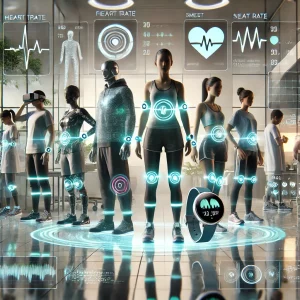
Wearable healthcare devices have moved beyond step counters and fitness trackers. Today, they are powerful tools that empower individuals to take control of their health while equipping healthcare professionals with the insights they need to save lives.
In 2023, 35% of U.S. adults used wearable healthcare devices, a rise from 27% in 2018. These devices are reshaping how we approach health, offering innovative ways to monitor vital signs, track fitness, and even manage chronic conditions. But the real story lies in how these technologies are transforming patient care and improving outcomes.
The Rise of Wearable Healthcare Devices
Wearables today are more than gadgets. They’re about empowerment, helping individuals monitor their health while enabling clinicians to detect issues early. Let’s explore how these technologies are making a difference.
1. Wearable and Ingestible Sensors: Real-Time Health Monitoring
From sensors that stick to the skin to ingestible pills, these devices capture bio-signals in real-time, offering unparalleled insights.
- Examples that stand out:
- Wireless sensors that measure glucose and heart rate.
- Electronic tattoos that provide continuous heart monitoring.
- Ingestible sensors that track medication adherence in psychiatric care.
Hospitals are leveraging these innovations to reduce risks and improve clinical decisions, creating safer environments for patients.
2. Fitness Trackers: Small Devices, Big Impact
Fitness trackers like Fitbits and smartwatches help users track steps, sleep patterns, calories, and heart health. But their role extends far beyond fitness goals.
- Studies show fitness trackers can reduce sedentary behaviour in hospitalised patients and speed up recovery.
- They inspire healthier habits, making them invaluable for both individuals and healthcare providers.
3. Smartwatches: More Than a Timepiece
Smartwatches are evolving into personal health assistants.
- Apple Watch features like ECG monitoring, sleep apnea detection, and heart health tracking are empowering users to take charge of their health.
- Samsung’s Galaxy Watches are used in cardiac rehabilitation programs, blending technology with personalised care.
These devices go beyond convenience, saving lives by detecting heart irregularities and improving overall care.
4. Virtual Reality (VR): A New Dimension in Care
VR headsets are now being used for pain management and mental health therapies.
- Mental health applications: Exposure therapy for anxiety and phobias.
- Pain management: VR distractions have been shown to reduce pain during treatments like burn dressing changes.
By immersing patients in tailored environments, VR delivers care that’s effective and personalised.
5. Smart Clothing: Innovation Woven In
Smart clothing embeds sensors into fabric to track health metrics like blood pressure and heart rate.
- MIT’s smart shoes help monitor gait during rehabilitation.
- Smart socks reduce pressure injuries in diabetic patients.
This seamless integration of health tracking into everyday life is paving the way for continuous monitoring and better outcomes.
Why It Matters
Wearable technology isn’t just about tracking data; it’s also about transforming lives. These innovations allow us to:
- Monitor health in real-time, reducing hospital stays.
- Manage chronic conditions more effectively.
- Create personalised care plans that adapt to individual needs.
As wearables continue to advance, the healthcare landscape will evolve, making care more accessible, proactive, and patient-focused.
